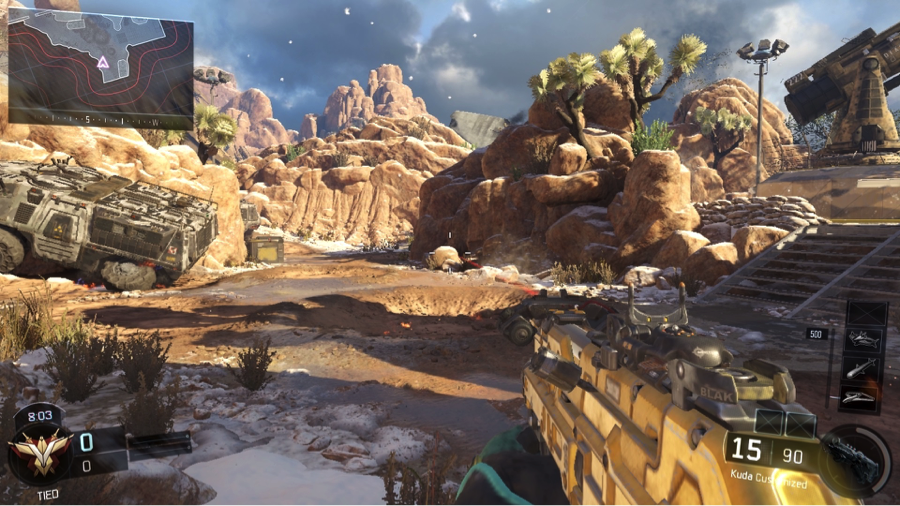

Photo courtesy Wikimedia.org/wikipedia/commons
First Person Shooters (FPS) often get a bad rap as a less sophisticated type of game compared to the slower-paced RPGs and the real-time strategy “war-chess” games like StarCraft. One of the most reaction-intensive types of games, FPSs are associated more with younger gamers, and are assumed to require less intelligence, and less abstract thinking.
It’s true that anyone who has played Call of Duty multiplayer online is well aware that the stereotype is not entirely without merit—there are plenty of nasally 11-year-olds eager to tell you what they plan on doing to your mother—but every community has its negative elements at the lower-skilled levels. Anyone starting out in League of Legends or Dota can confirm that bad behavior abounds in video games of all shapes and sizes.
But not only are FPS games dismissed without merit, there are aspects to the specific style of gameplay that real, rigorous science has shown to be especially beneficial compared to other games.
As FPSs became more popular in the ‘90s, huge titles like Doom and Goldeneye 007 really began to set the stage for what FPS games could be. Doom was the first game to successfully integrate multiplayer mode into gaming. This alone played a huge part in the growth of FPS gaming, and all gaming, for that matter.
Goldeneye 007 went on to perfect the capabilities of FPS gaming. Released in 1997, it eventually became the best-selling Nintendo 64 game in the U.S.. It was the first FPS to have an especially extensive single-player story mode, and features like the sniper rifle and headshots. After these games became ridiculously popular (and they still are in 2016), FPS gaming would forever be a huge staple in the gaming industry.
With the growth of multiplayer gaming that started with FPSs, LAN development became really popular. LAN (Local Area Network) parties were a chance for gamers to get together, with their own consoles or computers, and play a game together on a larger scale, against or alongside each other. This reduced the need for games to include great AI development, as developers wanted players to play against each other, not the AI. This left even more room for perfecting gameplay and multiplayer capabilities.
With the growth of online capabilities in gaming, online competitive play has since become the go-to form of FPS gaming. If you are playing Call of Duty, Halo, or Counterstrike, you are almost definitely playing against other people online, not single-player. These games, along with team-based FPSs like Team Fortress 2, have now become the gold standard for FPS gaming.
Yet, with XBox and PS4 now being regular sponsors of esports, games like Halo no longer being available for PC, and a generation of FPS gamers weaned on Goldeneye and Call of Duty, first person shooters are a console event.
Well-paid esports competitors will passionately argue the merits of both, but whatever the superior form of competition, the divide between console and computer FPS gaming has caused a huge divide in coalescing fan and sponsor support. “Gamers” are a huge chunk of the Western World, but with such stylistic loyalty, even a specific category like “FPS Gamers” will be very segmented.
Despite this divide, FPS pros still make it into the big leagues, and are regarded just as highly as any League of Legends pro might be. NaDeSHoT is considered to be the greatest Call of Duty player of all time, and other FPS gamers have made it onto lists of the best esports players in the world.
Neurons rapidly fire around in our brains, via dendrites. Repeated activities cause our brains to forge even stronger connections between these most-used neurons. This is true for whether we’re playing Bejeweled or becoming couch-experts at Wheel of Fortune. FPSs, however, are distinctly similar because of their simulation of an environment in which spatial awareness is key. When a basketball player takes a jump shot, the timing of his liftoff, the curve of his fingers, the force of his release of the ball from his palm—each of these physical activities has a real, physical effect on the brain’s architecture at the neuron-level. Likewise, every frag grenade bounced off a ceiling and every sniper shot diagonal through a window—the brain is being changed at a very foundational level to reinforce the skill it takes to achieve these activities.
While Candy Crush is definitely taking advantage of the way your brain works, one can’t exactly describe the cocaine-like addiction such games evoke in the brain as similar to the net-positive responsiveness one can gain by FPS training.
Still don’t believe FPS games are great for our brains? Studies show that surgeons with experience in FPS gaming are much better at performing the VR exercises they use for training. That’s right, even surgeons could learn a thing or two from FPS gaming.
The relationship between FPS gaming and brain activity is not something to be overlooked. It is no wonder these games are so popular and addicting. They make your brain work over-time, and exercise valuable mental skills. With all this newfound knowledge of FPS gaming, are you really all that surprised that esports are coming to the Olympics? We aren’t.